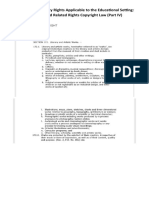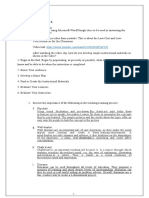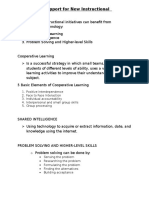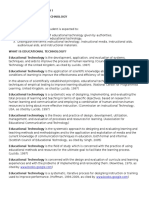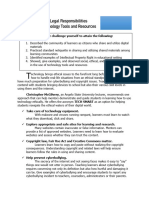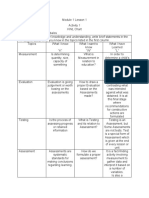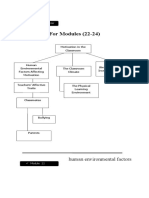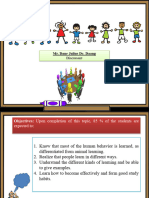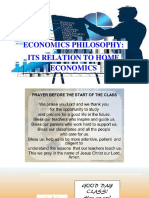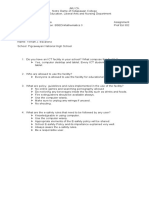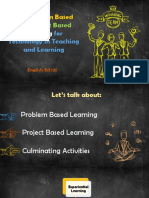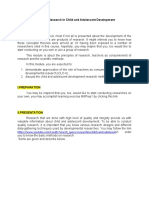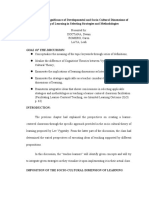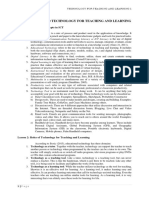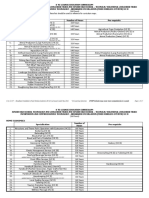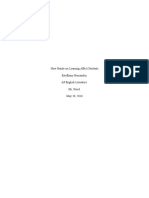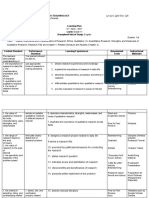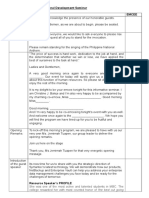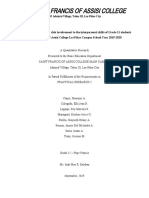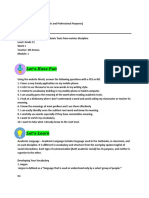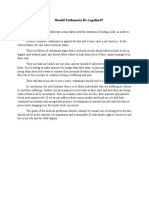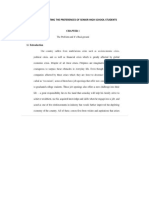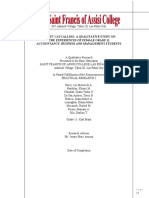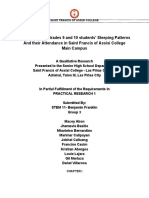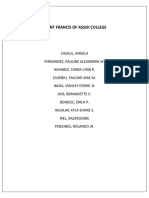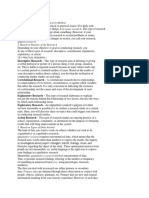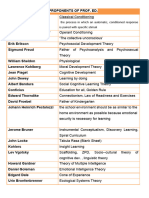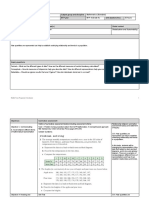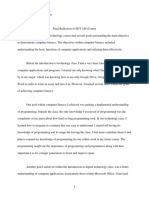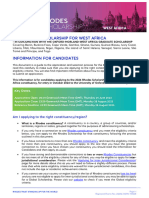Pamantasan ng Lungsod ng Muntinlupa
College of Teacher Education
THE DIFFICULTIES ENCOUNTERED WHEN USING HANDS-ON
LEARNING APPROACH IN HOUSEKEEPING 1 TO HOME ECONOMICS
STUDENTS IN
SAINT FRANCIS OF ASSISI COLLEGESCHOOL YEAR 2019-2020
A Qualitative Research
Presented to the Basic Education Department
SAINT FRANCIS OF ASSISI COLLEGE- LAS PINAS CAMPUS
Admiral Village, Talon III, Las Piñas City
In Partial Fulfilment of the Requirements in
PRACTICAL RESEARCH 1
Aguilar, Micah K.
Bulabos, Renniel M.
Buot, John Genson G.
Deloso, Erica Mae A.
Domingo, Rica Mae P.
Faustino, Liezel D.
Fernandez, Mark Angelo C.
Hinong, Nicolle Jillian M.
Lenis, Emely
Santos, Cer John Aulrich
Grade 11- Henry Sy Sr.
Mr. Jesary Marc Arnosa
Page
|1
�Pamantasan ng Lungsod ng Muntinlupa
College of Teacher Education
Page
|2
� Pamantasan ng Lungsod ng Muntinlupa
College of Teacher Education
Chapter I
INTRODUCTION
According to Donovan, people are intended to be versatile learners and are known
to be active agents in obtaining knowledge and skills more than any other species.People
have the ability to create, invent and pass on the knowledge that helps them in
understanding and exploiting their environment. We must master the knowledge we
acquired from the past succeeding generations. We can push people to their capabilities if
we are able to provide quality and strategic learning methods. This is an effective,
efficient, and practical way that can really push people to what they are able and what
they are not.
Students, when learning, tend to pay less attention when the method used in
teaching and exploiting lessons are boring and impractical. Nowadays, students crave for
visual and kinaesthetic learning. Simply put, they prefer excitement and thrill when it
comes to learning, and this is when strategies come in handy. Motivation is like passion
that will eventually fade over time if not constantly fed. Though, it sure will take a whole
lot of effort and time but one thing is for sure─ it is worth everything.
Technology enhances the student’s learning capabilities, particularly when
students use the technology directly. It can also improve the dynamics between teachers
and students, often leading to enhanced learning. There are millions of ways to make
effort and spice things up. Always remember that a motivated teacher produces motivated
learners.
Page
|3
� Pamantasan ng Lungsod ng Muntinlupa
College of Teacher Education
Hands-on learning, more formally known as experiential education, reflects a
teaching philosophy that promotes learning by doing. The strategy allows children to
practice guided tactile learning in which they absorb knowledge not only by listening, but
by experiencing. Experiential learning is praised as a top teaching method by higher
educational institutions, especially those in the fields of science, art and technology. This
strategy also offers numerous advantages to students in elementary classrooms.
Generally speaking, hands-on learning is learning through experience. Students
handle the materials, equipment, and instruments in real time and manipulate it. It is
obtaining the skills, knowledge, and competencies that are necessary. Working in hands-
on way is presumed to extend a more thrilling and realistic experience of the content. The
most verifiable researches bear evidence for the speculation that employing hands-on
activities steers to positive motivational result. Although there are also evidences that
adults may be over-challenged when independent problem-solving is involved during
these kinds of activities, especially those who are not used to open laboratory work were
found to be low in confidence regarding aspects of practical and hands-on work that
require analysis and critical thinking.
One of the benefits of hands-on learning environment is that students will get a
feel for materials and equipment that is commonly used in the workplace after the course.
This is particularly good if the student is working with equipment and tools. One of the
main reasons for accidents in the workplace comes from equipment and tools misuse;
knowing how to properly handle equipment increases safety.
Page
|4
� Pamantasan ng Lungsod ng Muntinlupa
College of Teacher Education
Once a concept has been taught and demonstrated, the time comes for students to
demonstrate their comprehension of the lesson. However the opportunity to demonstrate
knowledge is often given to students in the forms of worksheet, quizzes and tests. This
system adds pressure of performance and an attitude of evaluation to a time of learning
that should instead be treated as a practice period in which mistakes are allowed. In
contrast, hand on-learning allows students to experiment as they test concepts with tactile
equipment, learning as much from their failures as their successes.
By definition, hand-on learning requires students to engage in the education
process using multiple senses including sight, hearing and touch known as multisensory
learning;the hands-on teaching strategy engages the senses in a way that promotes
learning comprehension on multiple levels. This practice allows students to understand
information and also use it. For example, a young child may verbally acknowledge
understanding basic math facts, but is unable to solve problems on an addition worksheet.
Manipulating tactile math blocks allows that student to better comprehend the concepts
by actively utilizing acquired knowledge.
Hands-on learning allows students to directly take on board and understand what
is happening, or how to do something. This is a particularly successful way to teach
kinaesthetic learners, who learn best by examples. Beyond simply leading to better
engagement, hands-on learning allows students to practice the skills that they have
already learned. As anyone who has ever learned a skill or learned information can attest
to, the more practice you get, the better you will be at that skill, and the better you will be
Page
|5
� Pamantasan ng Lungsod ng Muntinlupa
College of Teacher Education
able to retain the information. When it comes to education, one of the most difficult
things for young children to understand is why what they are learning is important. They
want to know: When will I use this in my life? Why does it matter?
Improving and enhancing the methods used in teaching may help in improving the
students’ way of learning and may be used to their advantage. We are to find out if it does
really help and is it recommended to be used as a strategy by other teachers. As stated by
Tom Harris, with the use of kinaesthetic learning, we are able to use the power of the
person─ who they are and what they are. The inspirational role of a teacher is going to be
much greater.
Manyeducatorsuse hands-on learning nowadays for it provides a better and
strategy in improving the academic performance of their students. Using various
technology tools is number one in the list in order to enhance the learner’s performance.
Being equipped with the right materials in teaching may be a great help in this regard.
This is a commitment to exploring the opportunities technology has to offer for
improving the quality of learning of a student. Now that we know that hands-on learning
is effective and beneficial to students, what difficulties do these advances and
technologies bring to the students?
In this paper, the researchers will find the difficulties encountered using hands-on
learning approach in Housekeeping 1 to Home Economics students in Saint Francis of
Assisi College – Main Campus School Year 2019-2020.
Page
|6
� Pamantasan ng Lungsod ng Muntinlupa
College of Teacher Education
Theoretical Framework
The Advantages of Using Hands-On Learning Approach inHousekeeping 1 to Grade
11 Henry Sy Sr. inSaint Francis of Assisi CollegeSchool Year 2019-2020
The ASSURE model is a design model that is intended to create much effective
learning. (Kurt, 2015) The acronym stands for the six (6) steps that are connected in the
whole process. ASSURE stands for (1) analyze learners, (2) state standard and objectives,
(3) select strategies, technologies, media, and materials, (4) utilize technology, media,
and materials, (5) require learner participation, and (6) evaluate and revise. The ASSURE
model was used by educators to render the most suitable learning environment for their
students (Culatta, 2019).
Analyzing the learner’s needs is the first step. The teacher must know the age,
academic abilities, gender, interests, prior competencies, and the like of the learners. The
gathered information will help in making a decision and choose strategies with respect.
Setting standards and objectives to the learners are the next step in the model. The
learner must accomplish something after following such instructions. The teacher should
select strategies, technologies, media, and materials that will assist in bringing a positive
result. When the teacher has chosen a teaching strategy, it is time to determine which
technology, media, or materials will best support the teaching method to be used. This
ranges from simple tools such as crayons and blackboards to more sophisticated ones
such as presentations at power points.
Utilizing technology, media, and materials will now make its way in the process.
It involves creating a plan for the use of technology, media, and materials chosen. Like all
Page
|7
� Pamantasan ng Lungsod ng Muntinlupa
College of Teacher Education
the instructional steps, the teacher must ensure that his or her plans contribute to the
achievement of the targeted goals. In order to achieve this step, it is important to follow
the "5 Ps" process (Kurt, 2015); (1) preview the technology, media, and materials, (2)
prepare the technology, media, and materials, (3) prepare the environment, (4) prepare the
learners, and (5) provide the learning experience.
Requiring learner participation will lead in making a plan on how to actively
engage the learners with the material used in teaching. He or she needs to plan exactly
how the students will engage and participate in the learning process. How will the
information and techniques in a lesson be learned? The plan must be more specific than
just telling the learners to listen to the material and absorb it.
Evaluating the students’ feedback will count as the final step. Was their
experience positive? Did they experience any difficulties or challenges? Do they feel that
they have achieved the objectives and goals that were set? How will the teacher
determine whether the strategy was effective or not? Focus on evaluating the results
based on the learners’ feedback.
Of all the goals and objectives we have set, the main objective of this research is
to find out the difficulties encountered when using hands-on learning approach in
Housekeeping 1 to Home Economics students.
Conceptual Framework
The figure below shows how the researchers will make their way into conducting
a survey that will provide the data to be used into forming a solid conclusion. This depicts
the steps that the researchers will follow in order to make the study a success. The
Page
|8
� Pamantasan ng Lungsod ng Muntinlupa
College of Teacher Education
researchers are bound to find out the advantages of using hands-on learning approach to
Grade 11 students in Housekeeping 1using the steps under the ASSURE model.
Page
|9
� Pamantasan ng Lungsod ng Muntinlupa
College of Teacher Education
ANALYZE LEARNERS
- General attributes of your learner,
such as age, academic abilities,
gender, interest, etc.
- Prior competencies EVALUATE AND REVISE
- Learning styles, such as auditory, - Did your lesson meet the learning
visual, tactile, etc. objectives that you planned? How
will you determine whether the
students reach the objectives? Is
your way of assessing the students in
line with your learning objectives?
STATE STANDARDS AND - Can this lesson be improved?
OBJECTIVES How? How are you going to assess
- Audience ─ for whom is the
the weaknesses in your presentation?
objective intended?
- Was your choice of media and
- Behavior ─ what is the behavior to
materials a good one? How will you
be demonstrated?
assess the effectiveness of these
- Conditions ─ what are the
tools?
conditions under which the behavior
-Is it possible that other materials,
will be observed?
technologies, and media would have
- Degree ─ to what degree will the
done a better job?
knowledge or skill be mastered?
RESEARCH PARADIGM
F
O
R
M
A
T UTILIZE TECHNOLOGY,
I MEDIA, AND MATERIALS
V
E - Preview the technology, media, and
materials
E - Prepare the environment
V - Prepare the learners
A - Provide the learning experience
L
U
A
T
Figure 1. Research
I Paradigm
Select Strategies, Technology, Media, and Materials
O Page
N | 10
� Pamantasan ng Lungsod ng Muntinlupa
College of Teacher Education
Statement of the Problem
In the present day scenario, most of the students would pay attention if classes are
more interesting and fun. With that being said, it is safe to say that students prefer
learning by doing. There is a sufficient need for that attention to be dedicated at the
material. It will surely take so much effort and time but it sure will be worth it. The
researchers aim to learnwhat difficulties students encounter when using hands-on
learning approach in Housekeeping 1. This study will be conducted to know what
problems and challengesstudents face when using kinaesthetic learning. It sought to
answer the following questions:
1. What are the demographic profiles of the students?
1.1 Age
1.2 Gender
2. What are the difficulties that students encounter when using hands-on learning
approach?
3. How do these difficulties affect the students’ learning capabilities?
4. Are they able to manage and cope up with these difficulties they have
encountered?
5. How do students cope with these difficulties that they encounter?
6. As an educator, what should teachers do to avoid these problems from happening
and what techniques should they improve on?
Significance of the Study
Page
| 11
� Pamantasan ng Lungsod ng Muntinlupa
College of Teacher Education
There are various ways used by teachers in the present. Some of these include the
use of visual aids or even just using projectors, and some does practical exercises to help
students learn and engage more. These ways somehow boost the performance of students
when it comes to interactive learning and participation. The most effective among these is
using hands-on learning, and it sought to provide a thrilling, and much better learning
experience to the students. Despite its effectiveness, do students still encounter
difficulties when using this learning approach? If so, what are these difficulties?
This research paper will unfold difficulties encountered when using hands-on
learning approach or kinaesthetic learning to the Home Economics students when it
comes to learning Housekeeping 1. We are to find out what problems, conflicts, or
challenges doeskinaesthetic learning bring about to students. This research can be a great
reference to solve the problem of the majority of the students─ figuring out how they will
learn not only effectively, but conveniently. It could also serve as a guide to educators on
what ways do they need improvement on to boost their students’ academic performance.
STUDENTS
TEACHERS
PARENTS
SCHOOL
FUTURE RESEARCHERS
Scope and Limitations
Page
| 12
� Pamantasan ng Lungsod ng Muntinlupa
College of Teacher Education
This study aims to know the difficulties encountered by students when using
hands-on learning approach. This researchers will conduct the study at Saint Francis of
Assisi College Main Campus, a private, non-sectarian college system in Las Piñas City.
Out of 5 strands that the school offers, only 1 strand will serve as the target audience of
the study. This chosen strand will be Home Economics. We will conduct interviews that
will help us answer our research questions. The respondents for this research are
composed of students. The researchers will assure that these students have an experience
in hands-on learning and that they all take the subject of Housekeeping 1, so they will be
able to answer the questions easily.
Definition of Terms
Learning approach. This focuses on how students learn. It refers to the skills and behaviors that
children use to engage in learning for students take different approach to how they study,
depending upon the perceived objectives of the course they are studying.
Hands-on learning. Hands-on learning is an educational method that directly involves the
learner, by actively encouraging them to do something in order to learn about it. In short, it is
'learning by doing'.
Kinesthetic learning. Kinesthetic learning, kinaesthetic learning, or tactile learning is a learning
style in which learning takes place by the students carrying out physical activities, rather than
listening to a lecture or watching demonstrations.
Page
| 13
� Pamantasan ng Lungsod ng Muntinlupa
College of Teacher Education
Experential learning. Experiential learning is a process through which students develop
knowledge, skills, and values from direct experiences outside a traditional academic setting. It is
the process of learning through experience, and is more specifically defined as "learning through
reflection on doing". Hands-on learning can be a form of experiential learning but does not
necessarily involve students reflecting on their product.
Tactile learning. Tactile learning is a process of learning where information is best gained when
students experience the world themselves.
Academic performance. This is referred as a progress report of the success of a student which
can be affected by many factors. This also describes how well a person performs in terms of
academics.
Strategy. This refers to the action, way, or method intended to bring about a desired result, such
as solution to a problem or achievement of a certain goal. This also refers to a carefully developed
plan that aims to attain a certain goal or solution.
Difficulty. This refers to something that hinders you or causes you to have to face challenges, or
the state or condition of being challenged or having a hard time
Housekeeping. This refers to the management of duties and chores involved in the running of a
Page
| 14
� Pamantasan ng Lungsod ng Muntinlupa
College of Teacher Education
household, such as cleaning, cooking, home maintenance, shopping, laundry and bill payment.
These tasks may be performed by members of the household, or by other persons hired for the
purpose.
Multisensory learning. Multisensory learning is the theory that individuals learn better if they
are taught using more than one sense. The senses usually employed in multisensory learning are
visual, auditory, kinesthetic, and tactile – VAKT. Other senses might include smell, taste and
balance.
Page
| 15



